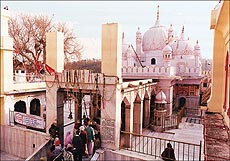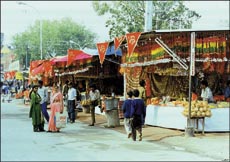As
many as five lakh pilgrims are expected to visit the
Mansa Devi temple during the navratra
fair beginning on September 21, says Pooja
Thakur
Navratra
fanfare at Mansa Devi shrine
 AN aura of divine benevolence
surrounds the Mansa Devi temple as lakhs of devotees pay
obeisance to the Devi during the navratras in the
months of April and September. Engulfed in an atmosphere
resonating with hymns, and surcharged with the
devotees’ immense faith in the goddess, the temple
glows with the warmth of religious fervour. AN aura of divine benevolence
surrounds the Mansa Devi temple as lakhs of devotees pay
obeisance to the Devi during the navratras in the
months of April and September. Engulfed in an atmosphere
resonating with hymns, and surcharged with the
devotees’ immense faith in the goddess, the temple
glows with the warmth of religious fervour.
According to mythology,
Mother Goddess represents Shakti (power), and each
form of the goddess is an embodiment of a specific shakti.
Mansa Devi is said to symbolise cerebral power that
controls vital functions of life. According to some
interpretations of Devi Bhagwat texts, the area
enclosed by the temple is one of the 108 places of
veneration (siddhapeeth) ascribed to Parvati, the
consort of Shiva.
Built on a hillock, the
Mansa Devi temple can be reached by a long flight of
stairs. The ancient temple was built by Rajha Gopal Singh
of Manimajra in 1815. His dedicated masons spent four
years to build the shrine which has a square base. The
main structure has domes and minarets.
A porch in the front leads
to a covered passage which is connected to a small front
verandah.
Within the precincts of
the temple stands an old tree where people light dhoop
and seek mannat from the deity.
Still higher on the
hillock, a couple of hundred metres away from the main
shrine, stands a shivala-like temple popularly
known as Patiala wala mandir. It was built by Raja
Ajmer Singh of Patiala around 1840 AD.
Since the management of
the Mansa Devi temple complex has been taken over by the
Haryana Government, it has donned a cleaner look and
adequate arrangements have been made for the pilgrims.
The complex is now being managed by a trust. Earlier the
shrine, controlled by priests, was in a state of neglect.
No efforts were made to maintain it or provide facilities
to the visitors. Now the scenario has changed for the
better.
The present administration
has also restored the paintings on the walls of the
ancient temple.
The paintings are reported
to have been created by Angad, a painter of Sirmour. The
erstwhile state of Manimajra was annexed by Sirmour at
one time, and Angad painted several interior and exterior
murals in the state.
The paintings on the walls
of the Mansa Devi temple are based on the themes derived
from Markanda Purana, which is dedicated to Mother
Goddess. A dozen or so paintings depict her different
forms assumed to slay demons Shumbha and Nishumbha. One
dated illustration, purported to be the portrait of the
Raja with a self-portrait of the painter, shows them
bowing to the goddess with folded hands.
Located at a distance of
about 10 km from the Chandigarh bus terminal and 4 km
from the Panchkula bus terminal, the Mansa Devi temple
can be reached by local buses or autorickshaws. The
Chandigarh Transport Undertaking and the Haryana Roadways
ply special buses during the navratra fair.
Expecting five lakh pilgrims during the coming fair, from
September 21 to 30 this year, the organisers are making
efforts to ensure the availability of good quality
eatables and provisions at reasonable rates.
Accommodation is available at the sarai, but only
for a limited number of people.
Whether one comes to seek
the blessings of the Devi, to perform the mundan ceremony
of one’s son, or to seek a mannat, one goes
back richly rewarded with happiness and peace of mind. 
|

